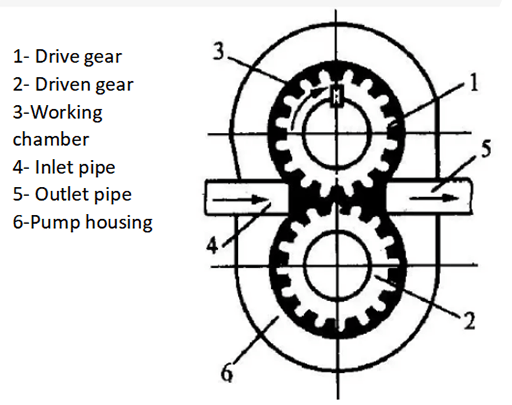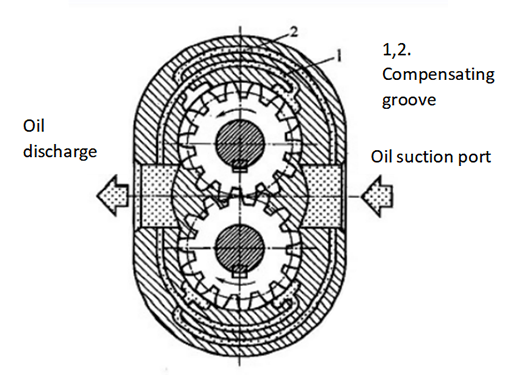
Figure 1: The cutaway view of the gear pump.
1. What is Gear Hydraulic Pump?
The hydraulic gear pump (gear oil pump) is a kind of positive displacement rotary pump. The conveying of the medium by the gear pump is completed by the volume change of the pump when it is working. It is composed of a pair of mutually meshing gears covered by a closely matching pump body.
2. How Does a Gear Pump Work?
The working principle of the hydraulic gear pump is that when the gear rotates, the volume of the space on the disengagement side of the gears increases from small to large, forming a vacuum to suck in the liquid, and that on the meshing side of the gears changes from large to small, and squeezes the liquid into the pipeline.
In terminology, hydraulic gear pumps are also called positive displacement devices, that is, like a piston in a cylinder, when one tooth enters the fluid space of another tooth, because the liquid is incompressible, the liquid and the tooth cannot occupy the same space at same time, so the liquid is mechanically squeezed out.
Due to the continuous meshing of the teeth, this phenomenon occurs continuously, thus providing a continuous discharge volume at the pump outlet, and the discharge volume is the same for each revolution of the pump. With the uninterrupted rotation of the drive shaft, the pump discharges fluid uninterruptedly. The flow rate of the pump is directly related to the speed of the pump.

Figure 2: The working diagram of external gear pump.
In fact, there is a small amount of fluid loss in the pump, because these fluids are used to lubricate the bearings and both sides of the gears, and the pump body can never be fit without clearance. So the fluid cannot be discharged from the outlet 100%, and a small amount of fluid loss is inevitable, which prevents the pump from operating at 100% efficiency. However, the pump can still operate well and can still achieve 93% to 98% efficiency for most extruded materials.
3. What are the different types of gear pumps?
There are many types of hydraulic gear pumps. According to different classification methods, they can be mainly divided into the following categories:
According to the tooth curve: it can be divided into involute tooth type and cycloid type.
According to the form of gear meshing, it can be divided into two types: external meshing type and internal meshing type.
According to the tooth surface form: it can be divided into four types: spur gear type, helical gear type, herringbone gear type, and arc tooth surface gear type.
According to the number of gear stages: it can be divided into single-stage gear pump and multi-stage gear pump.
According to the number of meshing gears: it can be divided into two-gear type and multi-gear type.
The external gear pump is shown as in the figure below, available in several gears such as straight teeth, helical teeth, and herringbone teeth. Generally, the involute tooth shape is used. The number of gears of the external gear pump is generally 2 to 5.
The internal gear pump is divided into involute internal gear pump (b) and cycloidal internal gear pump (c).
 and internal gear pump-min.png)
Figure 3: External gear pump (a) and internal gear pump (b, c).
The two gears of the cycloidal internal gear pump are different in shape and have different numbers of teeth. One of them is a ring gear (out gear, driven gear), which can float in the pump body, and the inner one is a drive gear, which has an eccentric position with the pump body. The number of teeth of the ring gear is one more tooth than that of the drive gear. The drive gear drives the ring gear to rotate together, and uses the change of the space between the two gears to transport the liquid.
Under the same flow rate, the size of the internal gear pump is smaller than that of the external gear pump. Compared to the external gear pump, the flow rate of the internal gear pump is more uniform and the manufacturing process is more complicated.
The number of gears in the external gear pump is 2 to 5, and the one with two gears is the most commonly used, while the internal gear pump has only two gears.
4. What are the Advantages and Disadvantages of Gear Pumps?
As a commonly used hydraulic pump, the gear pump can basically meet the needs and working requirements of the market. The hydraulic gear pump has the following advantages and disadvantages:
4.1 Advantages of Gear Pump
The hydraulic gear pump has the advantages of simple and compact structure, small volume, light weight, good manufacturability and low price. From the performance point of view, the gear pump has strong self-priming, insensitive to oil pollution, wide speed range, and can withstand impact loads. Another advantage of the gear pump is that it works reliably, and if there is a problem, it is easier to maintain.
4.2 Disadvantages of Gear Pump
However, the hydraulic gear pump also has certain shortcomings. For example, because the end cover and the inter-tooth grooves of the gear form many fixed sealed working chambers, it can only be used as a fixed displacement pump, not a variable displacement pump.
In addition, the gear pump has unbalanced radial force, large flow pulse, large noise, and relatively low efficiency. It is not easy to repair after wear and tear, and in many cases, the only way is to replace the pump assembly.

Figure 4: Balancing radial forces with compensating grooves.
5. What is a Gear Pump Used For?
The gear oil pump is suitable for transporting various oils, such as heavy oil, diesel oil, and lubricating oil, but not suitable for transporting media containing hard particles or fibers. Its applicable viscosity is 5×10-5 ~ 1,5×103m2/s, and the temperature is not higher than 70℃. If you need to transport high temperature liquid, please use a high temperature resistant gear oil pump, which can transport liquid below 300℃.
Applications for gear pumps include:
1. It can be used as transfer pump and booster pump in the oil delivery system;
2. It can be used as a fuel pump for delivery, pressurization and injection in the fuel system;
3. It can be used as a hydraulic pump to provide hydraulic power in the hydraulic transmission system;
4. It can be used as a lubricating oil pump in all industrial fields.
Compared with vane pump and piston pump, gear pump has lower efficiency, and the oil suction height is generally not more than 500mm. Due to its low efficiency, low pressure and low flow, it is mostly used in simple hydraulic systems with moderate speed and low force, and sometimes used as auxiliary hydraulic pumps. It can be used in general construction machinery, mining machinery, agricultural machinery and machine tools.
Related Info
How Does a Hydraulic Pump Work?How to Select a Hydraulic Pump
Hydraulic Pumps: Common Faults and Troubleshooting Methods
What is Hydraulic Pump? (Function, Types, Application&Selection Method)
Hydraulic Pumps:Types and Pros & Cons


